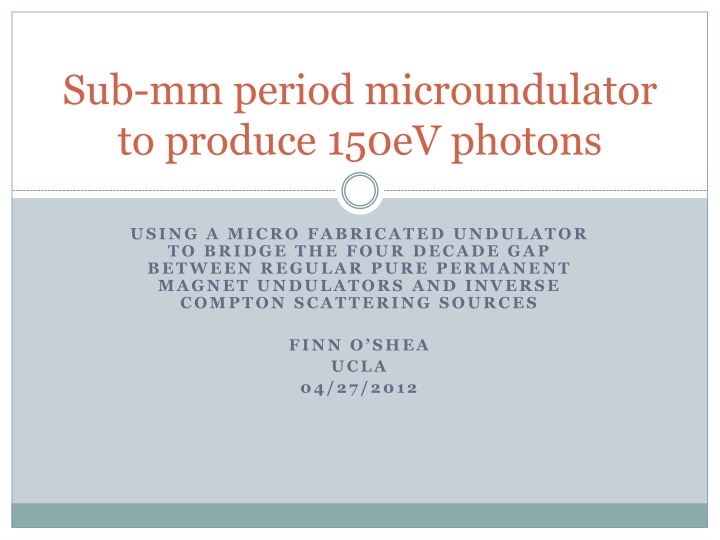
Next-Generation Sub-mm Period Microundulator for 150eV Photon Generation
"Exploring the innovative concept of a sub-mm period microundulator to produce 150eV photons, bridging the gap between regular permanent magnet undulators and inverse Compton scattering sources. This technology addresses the challenge of scaling beam energy and offers potential benefits in brightness and polarization control. Discover the proposed experiment, magnetic properties, benefits, and known unknowns associated with this cutting-edge advancement in photon generation."
Download Presentation

Please find below an Image/Link to download the presentation.
The content on the website is provided AS IS for your information and personal use only. It may not be sold, licensed, or shared on other websites without obtaining consent from the author. If you encounter any issues during the download, it is possible that the publisher has removed the file from their server.
You are allowed to download the files provided on this website for personal or commercial use, subject to the condition that they are used lawfully. All files are the property of their respective owners.
The content on the website is provided AS IS for your information and personal use only. It may not be sold, licensed, or shared on other websites without obtaining consent from the author.
E N D
Presentation Transcript
Sub-mm period microundulator to produce 150eV photons USING A MICRO FABRICATED UNDULATOR TO BRIDGE THE FOUR DECADE GAP BETWEEN REGULAR PURE PERMANENT MAGNET UNDULATORS AND INVERSE COMPTON SCATTERING SOURCES FINN O SHEA UCLA 04/27/2012
Outline The gap between visible light and hard x-rays Microundulator Parameters Why ATF? Proposed experiment
Photons with 80 MeV beam o1 cm period undulator will produce visible light o10 micron laser ICS will produce hard x- rays oGap is currently filled by changing the beam energy oThe problem scales with beam energy the four missing decades can only be filled by changing beam energy 1 cm undulator oMicroundulator bridges this gap 10 micron ICS 400 micron undulator
Simulation Profile Period: 400 m Magnet width: 200 m Magnet thickness: 500 m Magnet length: 2000 m Side Bar width: 200 m 50 periods long (2 cm) Material: laser cut NdFeB Taken from UF kickoff presentation (01/26/2012)
Magnetic Properties 0.3 T on axis peak field 50 T/m gradient due to side bars Current design limits maximum field, increase M to get more field.
Benefits Besides the coverage of the missing decades High peak brightness 2 1020 maximum brightness (diffraction limited) Experimental: 2 1016 ph/(mm2 mrad2 0.1% shot) Classical permanent magnet designs are well understood More exotic designs (APPLE, DELTA) to allow polarization control kHz switching (wavelength polarization) in the soft x-ray regime that doesn t currently exist at synchrotrons (force mitigation) Cheap disposable undulators?
Known unknowns Unknown field quality Can assembly be controlled well enough to get good field quality? Low K ~ 10-2, but scales well to mm period (K ~ 0.1 @ 2 mm) Wake fields Might be a problem for high current beams Demagnetization Cooling?
Why ATF? ATF has all the right stuff to test this technology: Low energy electron beam which does not typically create photons in the soft x-ray regime (GeV machines usually) Experience creating small, large aspect ratio electron beams for a 200 micron gap Ready Infrastructure: Detection efficiency MCP was designed for this energy range (40% efficiency) Beam positioning tried and true methods on beam line 2
Experimental Layout MCP is installed at the end of the straight section Undulator is installed in the Cerenkov wakes holder Optional: Multilayer used to filter 120 eV photons and direct them from directly downstream (noise suppression)
Experimental Goals Pulse wire measurement of 2nd integral of the undulator (field quality) 1st integral probably wont work without interferometer Simulation: Iy= 3.5 10-2 T mm -> 150 microradians IIy = 70 T mm2 -> 3 microns 2. Assess photon production ability Photon counting on MCP (1 week) Multilayer -> Bandwidth measurement (1 add. week) 3. Pulse wire after for damage 1.
Summary New technology that has features that current insertion devices cannot provide at ~100 MeV Accesses a new photon regime at ATF: soft x- rays Infrastructure already exists to do the experiment
EUVL P = 12 mW/A (beam current) @ 150 eV with 100 periods (1% bandwidth 1/Np) FODO type lattice for increased # of periods? Opening angle goes like 1/(gamma sqrt(Np)) for good quality undulator
